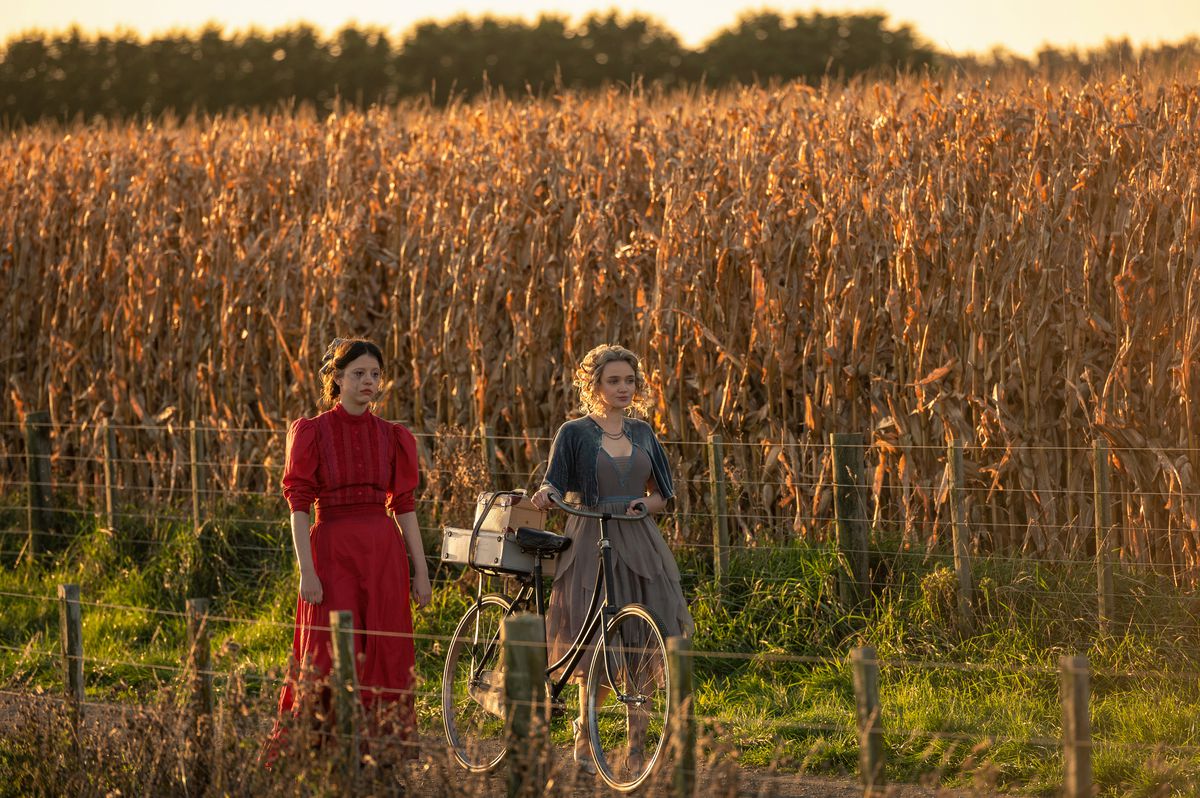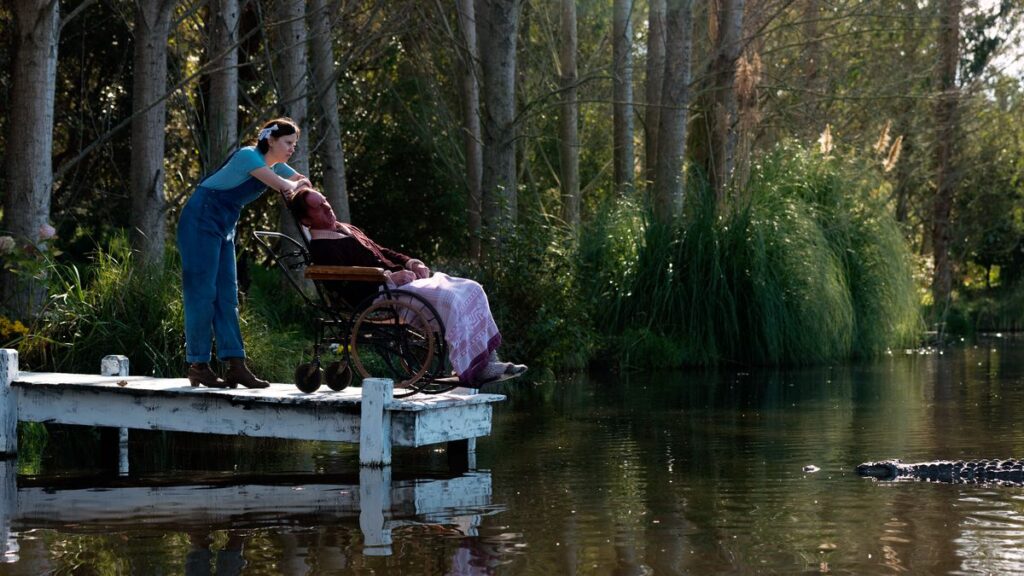[Ed. note: Significant spoilers ahead for Pearl.]
By the time Ti West’s Pearl hits its third act, there aren’t a lot of surprises left in store — just a heavy sense of dread and horror movie inevitability. That’s partially because Pearl is a prequel to West’s horror movie X, and anyone who saw that movie already knows where the title character (played once again by Mia Goth) eventually ends up. At the same time, the movie makes it clear just how ruthless and obsessive Pearl is, which sets up her final moves well in advance.
But there’s one particularly unconventional surprise — a six-minute, single-shot monologue where she lays out the details of her own psychosis and how she feels about the giant hole inside her that made her into a killer. West keeps a fixed camera close on Goth’s face the entire time as she fumbles through the darkness of her own psyche, one emotion chasing another across her face as she tries to explain herself to someone who isn’t even there. It’s a startlingly effective piece of acting and filmmaking, simultaneously minimalist and showy.
“From my side of the street, it was technically not all that complicated,” West tells Polygon. “It was two people sitting at a table in a studio. It’s the dream of how to film something — nothing can go wrong.”
Ironically, though, most of West’s focus in shooting the scene went into making sure nothing went wrong. “I was very much trying to stay out of Mia’s way, and trying to get the crew hyper-focused,” he says. “Once we got to the monologue, nobody was allowed to mess anything up. If anything was wrong — if there was a phone ringing, or someone was in an eyeline, or a mic was in the shot — it needed to happen prior to the monologue starting, because if something messed up, it’d kill the whole thing.”
Photo: Christopher Moss/A24
“The stakes were really big,” West says. “It was a little like filming a stunt or an explosion, because everything has to be technically prepared for this to happen effectively. So I was just doing my best to try to clear the road so Mia could do what she was going to do.”
Goth says that for her part, the main issue was getting over the fear of failure. “The lead-up was nerve-racking,” she says. “I had never done anything like that before. A lot of preparation went into it. I would go over my lines daily. The last thing I wanted to be doing on the day we were going to shoot was still going over my lines. If that had been the case, I would have failed before I stepped onto the set.”
West scheduled the scene for the final day of shooting, which Goth calls “a genius idea” that let her put “all of the intensity and emotional turmoil that came from shooting” into the scene. She says he offered her an out: “Don’t worry, if you’re unable to do it in one take, we can always cut.” But she was determined to get the scene down as he imagined it. “We just stepped onto set and shot it. Once we realized, ‘Okay, we can do this,’ we just started having fun with it. Maybe did it five, six times.”
Usually, by the final act, horror films are ramping up to a flurry of bloodshed or destruction. West bakes that into Pearl’s ending as well, but he really considered Goth’s monologue to be the movie’s flashy ending.
“This movie needed a big climax,” he says. “Even though it’s so rich aesthetically, and so flashy and escapist in style, the climax needed to be something internal and psychological, and very much about what Pearl’s thinking and feeling. And it became so literal: ‘Well, what if she just told us what’s going on in her head? How do we arrange that so it makes sense?’”
He wanted the monologue to be a single shot both in order to “connect with the audience, emotionally and psychologically” but also to provoke critical and audience interest and dissection — “[like] the conversation we’re having right now about it,” he says. He knew the shot would be memorable. “It’s this big climax, but it’s such an unexpected climax. No one expects the climax of a horror movie to be a close-up of someone’s face for six minutes. And that felt fresh and exciting.”

Photo: Christopher Moss/A24
West says that the entire X trilogy — X, Pearl, and the recently announced X sequel MaXXXine — is heavily focused on “highlighting the craft of filmmaking, whether that’s camera direction, or production design, or makeup effects, or whatever.” X revolves around a pornographic film being shot by a group of amateur ’70s filmmakers hoping to take advantage of the era’s increasingly accessible camera technology and film distribution, and make themselves rich and famous in the process — and the film itself is shot and constructed like a ’70s horror movie. Pearl, set in 1918, is about Pearl’s obsession with heading to Hollywood to become the latest star of the decade’s growing cinema boom. And the film is shot and constructed like a classic-era Technicolor melodrama, with a tone consciously taken from Disney movies. The first teaser for MaXXXine promises a film set in the ’80s VHS boom, with VHS visual stylizings and an ’80s synth score to match.
But West says he didn’t want the series’ focus on craft to be limited to technical aspects — he points out that acting is also a crucial craft for film, and that the single-shot monologue “seemed like a real way to showcase that craft.”
For Goth, that craft is also about getting out of her own way. The movie’s final shot is another long, unbroken take of Pearl’s face, as she confronts what she’s done throughout the movie and breaks down — all while maintaining a big, artificial Hollywood smile that gets progressively more and more unnerving as she shudders and weeps at the same time.
“Honestly, not much thinking was taking place during that scene,” Goth says. “You just hope all the work you do leading up to that scene […] you just hope you get to set and you’re able to let that all go, and that somehow the residue of all that [work] has left some sort of imprint on you, so by the time you get to set, you can just be as present as possible. I try not to think too much during a scene. I think that can be a little dangerous for an actor, that kind of takes you out of it. There’s more just feeling.”

